|
|
|
Sort Order |
|
|
|
Items / Page
|
|
|
|
|
|
|
| Srl | Item |
| 1 |
ID:
144773
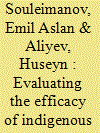

|
|
|
|
|
| Summary/Abstract |
This study seeks to identify factors conducive to the (in)efficacy of indigenous forces (IF) in counterinsurgency (COIN) operations in Russia’s republics of Chechnya and Dagestan. Empirically, it is the first study to offer an examination of the deployment of IF in the North Caucasus-based COIN. The findings of this article emphasize that the effectiveness of COIN in Chechnya, unlike Dagestan, is conditioned by a number of factors pertaining to the structural and organizational characteristics of IF. Of these, the IF’s experience as former insurgents, their access to insider information, and their loyalty to incumbents – often maintained by the threat of collective punishment – have proven decisive for a relatively successful COIN in Chechnya.
|
|
|
|
|
|
|
|
|
|
|
|
|
|
|
|
| 2 |
ID:
144771


|
|
|
|
|
| Summary/Abstract |
Hybrid warfare, or whichever nomenclature one chooses to use, has emerged as one of the most innovative and popular instruments in contemporary international politics and is in no way limited to post-Soviet spaces. This special issue offers a multi-layered account of interstate and intrastate dynamics with respect to insurgent violence in the former Soviet Union over an extended period of time. The contributors explore both internal dynamics with respect to insurgencies and civil wars and the roles of external constituencies – whether through the use of hard power (for example in directly supporting insurgent groups) or soft power (through the power of international aid and strategic communications). Most importantly, however, they provide an insight into the complicated and diverse range of conflict-related situations and experiences relevant to Russia’s ‘near abroad’. This collection also offers nuance to accounts that seek to explain complicated dynamics in the former Soviet space with a single overarching realist or neorealist metanarrative that can occlude important insights to be derived from more multi-layered perspectives.
|
|
|
|
|
|
|
|
|
|
|
|
|
|
|
|
| 3 |
ID:
144774
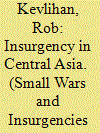

|
|
|
|
|
| Summary/Abstract |
This article considers the experience of civil war in Tajikistan (1992–1997). This civil war represents the most significant violent episode in post-Soviet Central Asia; over a five-year period at least 50,000 people were killed and approximately one tenth of the population were displaced. This article will examine the role of local and international actors during this civil war, with a particular focus on the role that international aid and aid agencies played in governance of vulnerable populations and the impact these interventions had on conflict dynamics and the ability of insurgents to govern in areas under their control.
|
|
|
|
|
|
|
|
|
|
|
|
|
|
|
|
| 4 |
ID:
144772
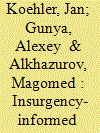

|
|
|
|
|
| Summary/Abstract |
In this article we analyse the dynamics of the insurgencies and the corresponding counter-insurgency measures in the North Caucasus over the past 25 years. By comparing three cases – Chechnya, Dagestan, and Kabardino-Balkaria – we identify similarities and differences in the way insurgencies and counter-insurgency measures influence governance in the region. Analysing different dynamics and outcomes under similar framework conditions – a federal state with a centralised government trying to govern a region with a shared history of rebellions against central rule and with similar geographic, social, and cultural features facilitating resistance and insurgencies – is a promising approach to better understanding conditions and implications of insurgency-induced governance in post-Soviet Russia.
|
|
|
|
|
|
|
|
|
|
|
|
|
|
|
|
| 5 |
ID:
144778
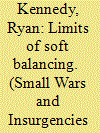

|
|
|
|
|
| Summary/Abstract |
Both the EU and NATO have greatly expanded efforts to address the frozen conflict in Transnistria since 2003. These efforts by and large fall neatly into the category of ‘soft balancing’ actions against Russian influence in the conflict and in Moldova more generally. Given that soft balancing is normally seen as a strategy undertaken by relatively weak actors vis-à-vis a global or regional hegemon, this behavior is puzzling. The actions of these institutions demonstrate that soft balancing is a logical strategy for stronger actors when the conflict is not as salient as for the weaker actor. The EU and NATO’s desire to resolve the conflict is not salient enough to warrant a costlier hard power strategy. Recent developments in Ukraine also demonstrate the limitations of this strategy. Specifically, the application of this soft power has done little to change the incentives for separatist leaders or their Russian backers, meaning they have little ability to resolve the conflict. They have also fallen short of creating a permanent pro-Western consensus in Moldova. They do, however, augment Moldova’s ability to adapt to the challenges posed by the conflict and provide a paper wall against more aggressive Russian ambitions in the region.
|
|
|
|
|
|
|
|
|
|
|
|
|
|
|
|
| 6 |
ID:
144776
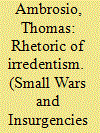

|
|
|
|
|
| Summary/Abstract |
Following the February 2014 fall of Viktor Yanukovych as president of Ukraine and the installation of a pro-Western government in Kiev, Russia initiated an irredentist intervention to annex the Crimean peninsula. Although much attention has focused on the use of military forces without country or unit insignia (the ‘little green men’ of irregular warfare), a crucial part of this operation involved a complex and multilayered perception management campaign to advance a self-interested narrative, which defined the contours of debate, justified their actions at home and abroad, and provided those actions with legal and normative legitimacy. This article examines the Kremlin’s rhetoric in three areas: Crimea’s secession from Ukraine was a legal act of self-determination; Russia possesses justifiable historical, cultural, and legal claims to Crimea; and, Western criticism of Russia’s actions are dishonest and a reflection of their anti-Russian, Cold War mentality.
|
|
|
|
|
|
|
|
|
|
|
|
|
|
|
|
| 7 |
ID:
144775


|
|
|
|
|
| Summary/Abstract |
This article focuses on how unrecognised states have tried to establish themselves domestically and internationally, and on the efforts of base states designed to counter these initiatives. Having provided an overview of the main features of post-Soviet unrecognised states, we examine the political systems found in these territories, focusing on their presidents, parliaments, and elections. We then focus on how unrecognised states strive to strengthen themselves through support from abroad, in spite of international isolation. Finally, we debate the strategies enacted by base states to counter such efforts and deny international legitimacy and recognition to these entities.
|
|
|
|
|
|
|
|
|
|
|
|
|
|
|
|
| 8 |
ID:
144777


|
|
|
|
|
| Summary/Abstract |
This article analyses Russia’s role in the Ukrainian crisis in the context of Moscow’s foreign policy historical development, underlining patterns of continuity and change in its policies towards the CIS. It argues that Russian foreign policy towards Ukraine results from a combination of two trends, reinforcing a Russian interventionist agenda: perceived threats to Russia’s interests in the near abroad and a radicalised and conservative national spectrum shaping foreign policy decisions. The combination of domestic and external factors driving Russia’s agenda in the near abroad raises important challenges for Russian society and its leaders as it does for its neighbours and partners.
|
|
|
|
|
|
|
|
|
|
|
|
|
|
|
|
| 9 |
ID:
144779
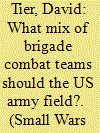

|
|
|
|
|
| Summary/Abstract |
During the past decade of war, the US Army has employed its forces in roles they were not intended to fulfill. The Army could have been better prepared if it had fielded a better mixture of forces. Instead of focusing on specific threats that narrowly specify which conflicts the Army will best be prepared for, the Army should maintain a broad range of capabilities that can meet a variety of circumstances. Accordingly, the Army should seek a force structure that exhibits a 3:1:1 ratio of Infantry, Armor, and Stryker brigade combat teams (BCTs) based on the possible range of conditions that US forces could face.
|
|
|
|
|
|
|
|
|
|
|
|
|
|
|
|
|
|
|
|
|